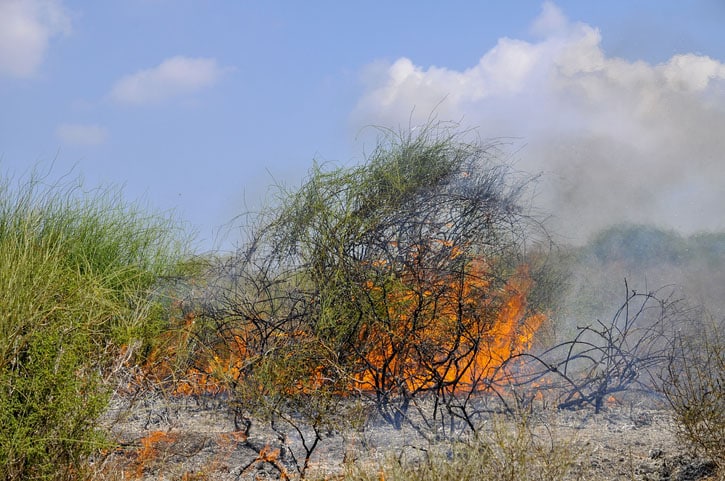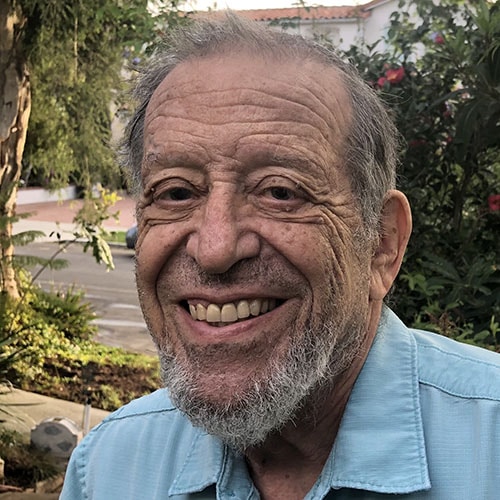 PhotoStock-Israel/Getty Images
PhotoStock-Israel/Getty Images When, as a shepherd, Moses turns,
recovering a straying lamb,
God tells him: “My name is ‘I Am,’”
the God within the bush that burns,
but strangely does not seem to be
consumed. He merely sees a flame,
and, once God has declared His name,
He, awed and modest, wants to flee.
“I don’t know what these words may mean,”
he tells God, seeming more concerned
about his lambs, for he had learned
to mistrust many sights he’s seen,
but God who’s called “I Am” demands
that Moses give up tending sheep
and with imagination leap,
performing all of His commands.
“I can’t,” he says, because his speech
is hard for men to understand,
but God insists that His demand
should be fulfilled, and makes him teach
His Words that later would hurled
in thunderbolts in that same spot
where He had stood, which heaven-hot,
gave Ten Commandments to the world.
The bush that burns was called a sneh,
a Hebrew word like Sinai, mountain
where lived Ten Commandments God was countin’
on giving them. Divine hearsay
was far too scary when announced
in God’s own voice, the Israelites
demanding that the wrongs and rights
by Prophet Moses be pronounced.
The bush’s flames don’t burn or shock
most people who have heard this tale,
and can’t be fanned by men who fail,
to tend as shepherds their frail flock,
although there are deluded men
who stray, believing that they see
in visions far beyond their ken,
from which all men who’re sane should flee,
And yet the mishkan tabernacle
where God for forty years once dwelt
would kindle flames that used to crackle
like flames in mines where Jews would smelt
for wise King Solomon red copper;
acacia, shittim, used to burn
like fire that made the bush non-stopper,
so Moses from the fire would learn
that he should use acacia to
light flames that constantly would crackle
in the candelabrum called menorah,
just like the bush, the tabernacle,
and all commandments in the Torah.
Exodus records the connection between the acacia wood from which the Israelites built the tabernacle in the wilderness and the copper that Solomon would mine in Timna in Exod. 35:24
כד כָּל-מֵרִים, תְּרוּמַת כֶּסֶף וּנְחֹשֶׁת, הֵבִיאוּ, אֵת תְּרוּמַת יְהוָה; וְכֹל אֲשֶׁר נִמְצָא אִתּוֹ עֲצֵי שִׁטִּים, לְכָל-מְלֶאכֶת הָעֲבֹדָה–הֵבִיאוּ. 24 Every one that did set apart an offering of silver and brass brought the LORD’S offering; and every man, with whom was found acacia-wood for any work of the service, brought it.
In “How the Timna Mines Went Bust: Iron Age copper mining caused large-scale environmental collapse, biblicalarchaeology.org, 10/21/22, Nathan Steinmeyer writes:
Nicknamed King Solomon’s Mines, Timna is located in the Arava Valley, 12 miles north of the Gulf of Aqaba and within the most arid region of the entire Negev Desert. Utilized since the Chalcolithic period (c. 4500-3300 BCE), the Timna mines were one of the most important sources of copper in antiquity. Yet in the ninth century BCE, mining at Timna came to a sudden halt, not to be restarted for nearly a thousand years.
…[A] new study by a Tel Aviv University team posits ….. that the over-exploitation of the already poor Timna ecosystem led to extreme environmental degradation, which in turn made continued mining financially unviable. The ecological effects of this event can still be seen in the area around Timna, where acacia trees and other desert flora are all but absent….
The Timna mines reached their zenith around the tenth century BCE, the period of the biblical kingdom of David and Solomon in the Judean Highlands. Only a century later, however, this production entirely disappeared.
….. The Timna mines reached their zenith around the tenth century BCE, the period of the biblical kingdom of David and Solomon in the Judean Highlands. Only a century later, however, this production entirely disappeared……
Over the years, spent charcoal was routinely placed on the same pile, leaving a stratified sequence that can be studied much like an archaeological mound. Through analysis, the team was able to determine the specific types of fuels used in the smelting process.
The team found that for much of the 11th through tenth centuries, the main sources of fuel were acacia trees and white broom bushes. Both of these grow throughout the region, and acacia is frequently mentioned as being used by the Israelites during their 40 years wandering in the desert (Exodus 25:10). However, the most important quality of acacia and white broom is their caloric density, which allows for their coal to burn much hotter. This, in turn, makes them far more efficient for smelting. During the 11th through tenth centuries, acacia and white broom made up nearly 90 percent of the fuel used for smelting the hundreds of tons of copper produced at Timna. Yet this mass-scale smelting would have required far greater quantities of acacia and white broom than the area around Timna was capable of producing.
By the end of the tenth century, the sources of fuel swiftly changed to less efficient sources such as date palms. With the nearest oasis capable of growing palms located miles away from Timna, the team suggests that the acacia trees and white broom bushes had been harvested to extinction in the area surrounding the mines, leaving no choice but for the miners to continually go further and further afield just to harvest less and less efficient materials. This did not only affect the financial viability of the mines, however but the very environment.
The acacia tree is a keystone plant within the desert ecosystem of the Negev. Numerous other plants and animals rely on the acacia tree as it provides shade, and food, and traps large quantities of water within the ecosystem that would otherwise be lost. As a result, species diversity within the Negev can be directly linked to the number of acacia trees. Yet, these long-lived trees have infrequent periods of recruitment, making them incredibly vulnerable to overharvesting. Overharvesting was exactly what they experienced. “…. once you add the human element into this equation and you have people industrially removing the vegetation for smelting fuel, cooking, building tents, and feeding animals, you are upsetting a system that is already fragile.”
Calculating the amount of copper produced, the amount of fuel needed, and the percentages of each plant used for fuel, the team estimated that from the eleventh through ninth centuries, the Timna mines could have used nearly ten thousand acacia trees and hundreds of thousands of white broom bushes. With the acacia trees and white broom bushes of Timna, all but annihilated, the ecosystem collapsed, and biological diversity in the area plummeted. The sudden lack of adequate amounts of fuel in the area rendered the Timna mines financially unviable.
Worse yet, the effects of that environmental disaster were so detrimental to the region, that even today they can still be noticed in the area surrounding the mines where biological diversity remains noticeably lower than in other areas of the Arava Valley.
I wonder whether there may be a link between the acacia tree, called shittim in the Torah, and the Burning Bush, and whether this link explains not only why the tabernacle was constructed out of acacia but why a lamp should constantly burn in it—- a law that rabbinic law applies to every synagogue, echoing the Burning Bush, ideally fueled by olive oil rather than by acacia wood. Exod. 27:20 states:
כ וְאַתָּה תְּצַוֶּה אֶת-בְּנֵי יִשְׂרָאֵל, וְיִקְחוּ אֵלֶיךָ שֶׁמֶן זַיִת זָךְ כָּתִית–לַמָּאוֹר: לְהַעֲלֹת נֵר, תָּמִיד. 20 And thou shalt command the children of Israel, that they bring unto thee pure olive oil beaten for the light, to cause a lamp to burn continually.
Gershon Hepner is a poet who has written over 25,000 poems on subjects ranging from music to literature, politics to Torah. He grew up in England and moved to Los Angeles in 1976. Using his varied interests and experiences, he has authored dozens of papers in medical and academic journals, and authored “Legal Friction: Law, Narrative, and Identity Politics in Biblical Israel.” He can be reached at gershonhepner@gmail.com.























 More news and opinions than at a Shabbat dinner, right in your inbox.
More news and opinions than at a Shabbat dinner, right in your inbox.